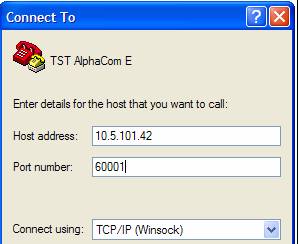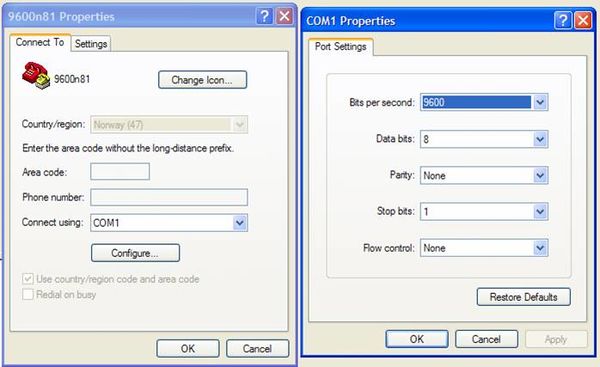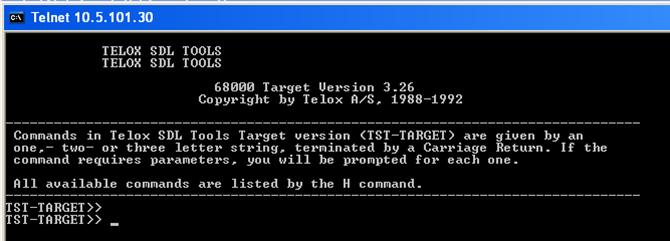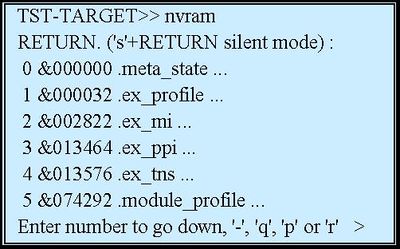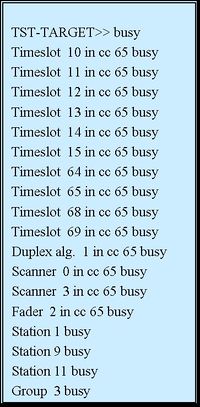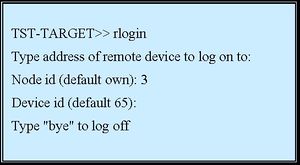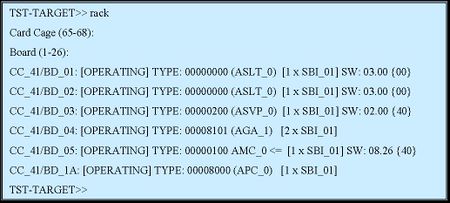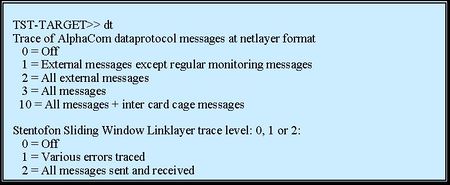TST console
From Zenitel Wiki
The TST console is a part of the AlphaCom Software. It is primary used as a debugging tool for software development. The TST console can be useful for troubleshooting. The TST console gives direct access to the AMC NVRAM memory, making it possible to modify parameters not available from the AlphaPro programming tool. The TST console is accessed via a simple terminal interface. A PC with a terminal emulator program such as Hyper Terminal can be used.
Contents
over IP
- TST Console via IP
- - Create a new connection in HyperTerminal
- - Host adress = IP-address of the AMC board
- - Port number must be 60001 (AlphaPro port)
- - When connecting you will be promped for username and password (admin + alphaadmin)
<br\><br\><br\><br\><br\><br\><br\><br\><br\><br\><br\>
over Serial Port
- TST Console via serial port
- - Enable AlphaPro on Serial port 0: S601-1 ON
- - Connect the PC com port to AlphaCom serial port 0
- - Start Windows HyperTerminal
- PC serial port setting: 9600 baud, 8 data bits, no parity, 1 stop bit
<br\><br\><br\><br\><br\><br\><br\><br\><br\><br\><br\><br\><br\><br\><br\><br\><br\><br\><br\><br\><br\><br\><br\>
Start and Stop
- TST Activation Code: #SERVICE* (no echo)
- - Response on VDU: TST-TARGET>>
- - New log-on required after reset
- Stop TST:
- - Type bye, or
- - Reset exchange
- - If not stopped properly, AlphaPro will not communicate
from Linux console
- TST Console can also be started from the Linux Console
- Simply type ”tst” on the Linux prompt...
<br\><br\><br\><br\><br\><br\><br\><br\><br\><br\><br\><br\>
- ...and the TST Console is activated:
<br\><br\><br\><br\><br\><br\><br\><br\><br\><br\><br\><br\><br\><br\><br\><br\>
Command Overview
“xh” – Command Overview Some commands:
| bye | - Exit command |
| nvram | - Edit NVRAM |
| busy | - list busy resources |
| err | - List Error Reports |
| rlogin | - Log on to TST on remote system |
| rack | - List Boards / Hardware Resources of a board |
| xh | - Help text |
| dt | - (AlphaCom) Dataprotocol Trace mode |
| sswrep | - (SSW) Report messages received |
| globgrp | - list global group node memberships |
NVRAM editor
”nvram” – NVRAM editor
- Inspect / modify the AMC’s nvram
- Modification will not be part of the AlphaPro database
- How to use:
- - You get a menu with line numbers
- - Enter a number to select a menu line
- - When a value is displayed, change it by typing a new number, then <enter>
- - Back one step: ”-”, then <enter>
- - Quit NVRAM editor: ”q”, then <enter>
- - Text strings are presented as a table of byte values
- See the text: ”p”, then <enter>
- Non-pritable chars are presented as hex digits \x00
- Change text: ”r”, then <enter>
- Use the letter ”>” before the start of text
List Busy Resources
”busy” – List Busy Resources
- Shows resources currently in use:
- - Timeslots
- - Faders
- - Scanners
- - duplex algoritms
- - Stations
- - group calls
Read Error Buffer
”err” – Read Error Buffer
- International buffer in NVRAM were special events are logged
- Read out buffer to get general impression of the health of the exchange
- Find exact reason for a reset
- The information is very ”software technical”
- Included in the general logging facilities of AlphaCom E
- - Log source ”AlphaCom Debug Log”
- Three levels:
- - Disaster – Exchange reset. The state of the exchange is so bad that the software does a controlled reset to restore normal operation.
- - Error – The software handles a problem by e.g. aborting an operation and returning to idle, but logs a message
- - Warning – Information to the user. Often identical to texts sent to the log port
Remote Login
- ”rlogin” – Remote TST Console Feature
- - Log on to the TST on remote node or slave modules
<br\><br\><br\><br\><br\><br\><br\><br\><br\><br\><br\><br\>
- - Type ”bye” to revert back to local exchange, and ”bye” once again to exit TST
List Boards
rack” – List Boards
- Gives overview of boards and hardware resources of a board
- Type ”rack” + <enter> + <enter> to list all boards
<br\><br\><br\><br\><br\><br\><br\><br\><br\><br\><br\><br\><br\><br\><br\>
Data Link Trace
"dt” – Data Link Trace
- Useful to debug AlphaNet or other Data Protocol problems
- Activate by typing ”dt” + <enter>:
<br\><br\><br\><br\><br\><br\><br\><br\><br\><br\><br\><br\><br\>
| To activate a continous error trace: | dt + <enter> + <enter> + 1 + <enter> | |
| Turn off the trace | dt + <enter> + <enter> + <enter> | |
| AlphaNet idle frames: | dt + <enter> + 2 + <enter> + 2 + <enter> | |
| AlphaNet application messages: | dt + <enter> + 1 + <enter> + 2 + <enter> | |
| AlphaNet occational failures: | dt + <enter> + 1 + <enter> + 1 + <enter> | |
Data Link Statistics
”sswrep” – Data Link Statistics
- Shows quality statistics on a data link
- Useful if problems with AlphaNet
- The ”sswrep” command asks for serial port number
- Three counters are displayed:
- - P1: Total number of messages received
- - P2: Number of messages with wrong checksum received
- - P3: Number of messages received out of sequence
<br\><br\><br\><br\><br\><br\><br\><br\><br\><br\>
- - The counters are set to 0 when the total number of messages received reaches 50000

